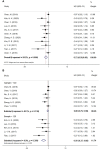Long-Term Survival in Nonsurgical Esophageal Cancer Patients Who Received Consolidation Chemotherapy Compared With Patients Who Received Concurrent Chemoradiotherapy Alone: A Systematic Review and Meta-Analysis
- PMID: 33489910
- PMCID: PMC7817852
- DOI: 10.3389/fonc.2020.604657
Long-Term Survival in Nonsurgical Esophageal Cancer Patients Who Received Consolidation Chemotherapy Compared With Patients Who Received Concurrent Chemoradiotherapy Alone: A Systematic Review and Meta-Analysis
Abstract
Background: Concurrent chemoradiotherapy (CCRT) is the standard treatment for nonsurgical esophageal cancer (EC). However, esophageal cancer patients receiving CCRT alone are still unsatisfactory in terms of local control and overall survival (OS) benefit. Clinicians generally add consolidation chemotherapy (CCT) after CCRT. It remains controversial whether CCT following CCRT is beneficial for esophageal cancer. We, therefore, undertook a meta-analysis to assess the need for CCT in inoperable esophageal cancer.
Materials and methods: We combed PubMed, Embase, Cochrane Library, Web of Science, and CNKI for relevant published articles up to July 2020 that compared CCRT plus CCT to CCRT alone for patients with nonsurgical EC. Our primary endpoint was OS and progression-free survival (PFS), and the secondary endpoint was treatment toxicity. We analyzed the hazard ratio (HR) to estimate the time-to-event data and the odds ratio (OR) to compare the treatment-related effect. To assess heterogeneity, we performed the I2 test and examined publication bias using funnel plots analysis.
Results: The 11 retrospective studies involved 2008 patients. Of these 2008 patients, 1018 received CCRT plus CCT, and 990 received CCRT. Compared to CCRT alone, CCT after CCRT did not improve disease control rate (DCR) (OR 1.66; 95% CI 0.53-5.15, p=0.384) and objective response rate (ORR) (OR 1.44; 95% CI 0.62-3.35, p=0.393). However, OS (HR 0.72; 95% CI 0.59-0.86, p < 0.001) and PFS (HR 0.61; 95% CI 0.44-0.84, p=0.003) did increase. Our results show that CCT plus CCRT had a clear survival advantage over CCRT alone. The risk of treatment toxicity did not increase for EC patients who received CCT.
Conclusion: CCT after CCRT significantly increases OS and PFS in patients with nonsurgical EC and could provide them remarkable survival benefits. The results provide an evidence-based framework for the use of CCT after CCRT.
Keywords: chemoradiotherapy; consolidation chemotherapy; esophageal cancer; meta-analysis; toxicity.
Copyright © 2021 Xia, Liu, Qin, Di, Zhang, Sun and Ge.
Conflict of interest statement
The authors declare that the research was conducted in the absence of any commercial or financial relationships that could be construed as a potential conflict of interest.
Figures






Similar articles
-
First-line induction or consolidation chemotherapy combined with concurrent chemoradiotherapy for esophageal squamous cell carcinoma.J Gastrointest Oncol. 2024 Dec 31;15(6):2389-2399. doi: 10.21037/jgo-24-599. Epub 2024 Dec 18. J Gastrointest Oncol. 2024. PMID: 39816011 Free PMC article.
-
Addition of Induction or Consolidation Chemotherapy in Definitive Concurrent Chemoradiotherapy Versus Concurrent Chemoradiotherapy Alone for Patients With Unresectable Esophageal Cancer: A Systematic Review and Meta-Analysis.Front Oncol. 2021 Sep 13;11:665231. doi: 10.3389/fonc.2021.665231. eCollection 2021. Front Oncol. 2021. PMID: 34589418 Free PMC article.
-
The effect of consolidation chemotherapy after concurrent chemoradiation on the prognosis of locally advanced cervical cancer: a systematic review and meta-analysis.J Obstet Gynaecol. 2022 Jul;42(5):830-837. doi: 10.1080/01443615.2021.2012437. Epub 2022 Feb 11. J Obstet Gynaecol. 2022. PMID: 35148230
-
Consolidation Chemotherapy Provided Survival Benefit for Esophageal Squamous Cell Carcinoma Patients Who Underwent Concurrent Chemoradiotherapy Lower Than 60 Gy.Thorac Cancer. 2025 Apr;16(7):e70012. doi: 10.1111/1759-7714.70012. Thorac Cancer. 2025. PMID: 40176263 Free PMC article.
-
Consolidation chwemotherapy after concurrent chemoradiotherapy vs. chemoradiotherapy alone for locally advanced unresectable stage III non-small-cell lung cancer: A meta-analysis.Mol Clin Oncol. 2016 Aug;5(2):271-278. doi: 10.3892/mco.2016.910. Epub 2016 May 23. Mol Clin Oncol. 2016. PMID: 27446563 Free PMC article.
Cited by
-
Consolidation chemotherapy after definitive concurrent chemoradiotherapy in patients with inoperable esophageal squamous cell carcinoma: a multicenter non-inferiority phase III randomized clinical trial.BMC Cancer. 2024 Mar 7;24(1):321. doi: 10.1186/s12885-024-12002-5. BMC Cancer. 2024. PMID: 38454345 Free PMC article.
-
First-line induction or consolidation chemotherapy combined with concurrent chemoradiotherapy for esophageal squamous cell carcinoma.J Gastrointest Oncol. 2024 Dec 31;15(6):2389-2399. doi: 10.21037/jgo-24-599. Epub 2024 Dec 18. J Gastrointest Oncol. 2024. PMID: 39816011 Free PMC article.
-
Real-world treatment patterns and survival for locally advanced esophageal squamous cell carcinoma.Medicine (Baltimore). 2023 Aug 25;102(34):e34647. doi: 10.1097/MD.0000000000034647. Medicine (Baltimore). 2023. PMID: 37653737 Free PMC article.
-
Consolidation Chemotherapy Rather than Induction Chemotherapy Can Prolong the Survival Rate of Inoperable Esophageal Cancer Patients Who Received Concurrent Chemoradiotherapy.Curr Oncol. 2022 Sep 2;29(9):6342-6349. doi: 10.3390/curroncol29090499. Curr Oncol. 2022. PMID: 36135068 Free PMC article.
-
Consolidative chemotherapy after definitive concurrent chemoradiotherapy for esophageal squamous cell carcinoma patients: a population based cohort study.BMC Gastroenterol. 2022 Aug 10;22(1):381. doi: 10.1186/s12876-022-02464-x. BMC Gastroenterol. 2022. PMID: 35948871 Free PMC article.
References
-
- Short MW, Burgers KG, Fry VT. Esophageal Cancer. Am Fam Physician (2017) 95(1):22–8. - PubMed
-
- Davies L, Lewis WG, Arnold DT, Escofet X, Blackshaw G, Gwynne S, et al. Prognostic significance of age in the radical treatment of oesophageal cancer with surgery or chemoradiotherapy: a prospective observational cohort study. Clin Oncol (R Coll Radiol) (2010) 22(7):578–85. 10.1016/j.clon.2010.05.023 - DOI - PubMed
Publication types
LinkOut - more resources
Full Text Sources
Other Literature Sources

